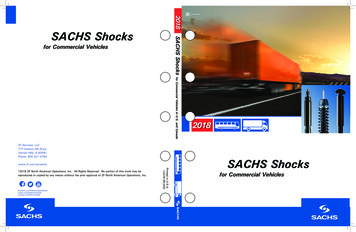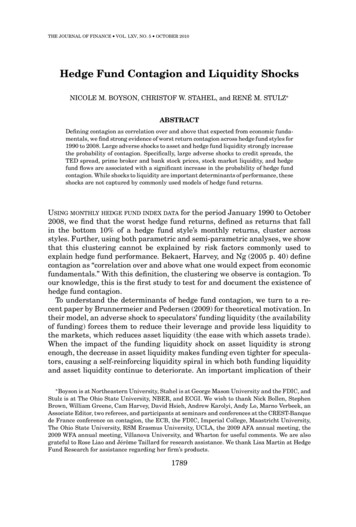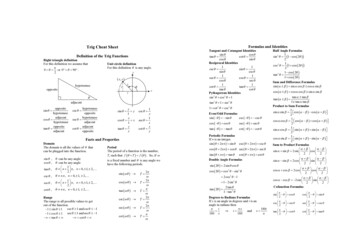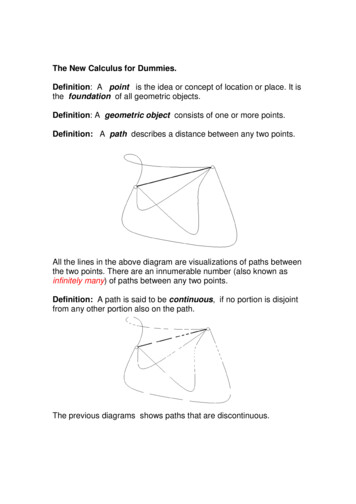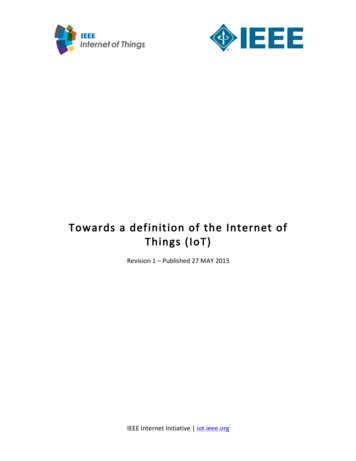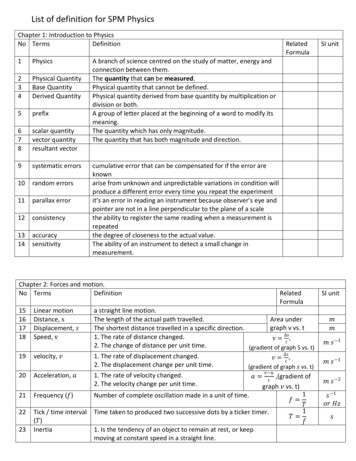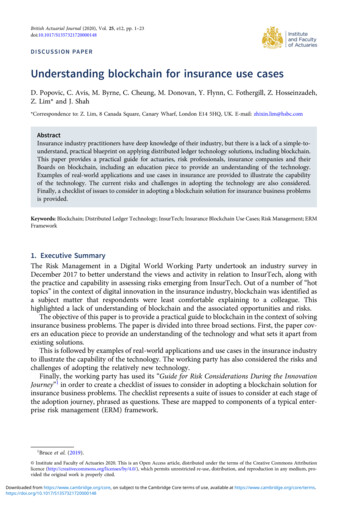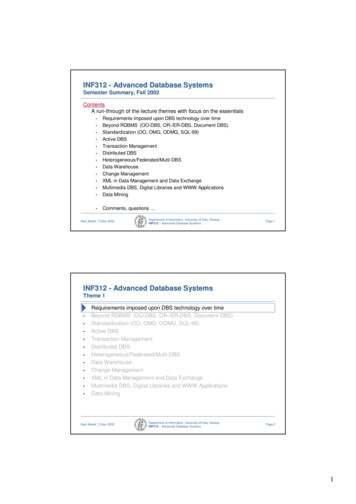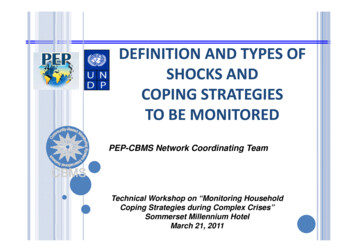
Transcription
DEFINITION AND TYPES OFSHOCKS ANDCOPING STRATEGIESTO BE MONITOREDPEP-CBMS Network Coordinating TeamTechnical Workshop on “Monitoring HouseholdCoping Strategies during Complex Crises”Sommerset Millennium HotelMarch 21, 2011
OUTLINE OF PRESENTATIONSHOCKS,, COPING STRATEGIES,, &RECOVERYI. DefinitionII. NatureIII TypologyIII.IV. Empirical literatureV. What info to collect
DEFINITION OF SHOCK IN LITERATURE1. Shock is an event that can trigger decline inwell-being,ll bwhichh h can affectffindividualsd d l(illness, death), a community, a region, oreven a nation (natural(l disaster,dmacroeconomic crisis). (World Bank, 2000-01)2. When a risk materializes, it can become a shock,whereby a shock refers to a risk that causes a“significant” negative welfare effect (e.g., majorincome loss, or major illness related costs).(Heitzmann, Canagarajah, & Siegel, 2002)
DEFINITION OF SHOCK IN LITERATURE3. Shocks are events that can reduce group orindividual well being, such as illness,unemployment,p y, or drought,g , and which mayythemselves cause or compound poverty.(Marques, 2003)4. The manifestation of risk (as a shock) also leadsto undesirabledbl welfarelfoutcomes. (Hoogeveen,(Tesliuc, Vakis, & Dercon, 2005)
DEFINITION OF SHOCK IN LITERATURE5. Shocks refer to the realization of different statesof the world. Examples of shocks include theoccurrence off an earthquake,thk substantialb t ti lmovement in terms of trade, or the death of ahousehold member.member (Kozel,(Kozel FallavierFallavier, & BadianiBadiani,2008)
DEFINITION OF SHOCKShock-Refers to an actual event-May resultl to incomeiandd nonincomeco e lossesosses foro householdouse o d-Associated with uninsured risk
NATURE OF SHOCKSShocks are distributed across space and time.Frequencycommon ----- rareDurationone-offff ----- persistenti t tIntensityild catastrophict thimild ----- Idiosyncrasylimited ----- widespread
TYPOLOGY OF SHOCKSShocks are typically classified based on scope ororigin.gId i o s y n c ra ti cM i cr oC o v ar ia n tM e soS co p eM a cr oIdiosyncratic shocks affect individuals orhouseholds. On the other hand covariant shocksaffect groups of household, communities, regions oreven entire countries.ShocksShk can bbe natural,l hhealth-related,l h l d social,i leconomic, political, or environmental.
SHOCKS ACCORDING TO SCOPEIdiosyncratic shockege.g.-illness-injuryinjury-death-jobjob loss-crop failure-loss of transfersCovariant shockege.g.-armed conflict-financialfinancial crisis-changes in food prices-droughtdrought-flood-social unrest
SHOCKS ACCORDING TO ORIGINNatural lone-earthquake-volcanic eruption-tsunamitsunamiEconomic shocke.g.-business closures-mass layoffsprice increases-price-job loss-wage cuts-lossloss of remittancesSocial shocke.g.-civil unrest-war-crime-evictionviolence-violenceHealth shocke.g.-serious illness-injury-death
DEFINITION OF COPING IN LITERATURE1. Coping is defined as a short-term strategyadopted within the prevailing value systemto avert a negative effect on the actor.(Davies 1993 & Gore,(Davies,Gore 1992 in Sauerborn,Sauerborn1996)2 Coping is an array of short2.short-termterm strategiesadopted in response to crisis. (Davies, 1993in Adams et.et al,al 1998)3. Coping strategies or mechanisms areremedialdi l actionsiundertakendk byb peoplelwhose survival and livelihood arecompromisedi d or threatened.hd (WHO,(WHO 1998)
DEFINITION OF COPING IN LITERATURE4. Copingp g strategiesg referf to all strategicallygyselected acts that individuals and householdsin a ppoor socio-economic situation use torestrict their expenses or earn some extraincome to enable them to ppayy forf the basicnecessities and not fall too far below theirsociety’sy level off welfare.f((Snel & Staring,g,2001)
DEFINITION OF COPING IN LITERATURE5. Coping strategies are strategies designed torelieve the impact of the risk once it hasoccurred. (Holzmann, 2001)6. Coping means the managing of resources indifficult situations. It includes finding waysto solve problems, to handle stress or todevelop defense mechanisms. (Bhrami &Poumphone, 2002)
DEFINITION OF COPINGCopingp g mechanism or strategygy-Pertains to a reaction triggered byan adverse event-Can be characterized as acalculated and rational move-IntendedIntended to minimize impact ofshock on wellbeing
NATURE OF COPINGCoping strategies are complex set of behaviorsDependent on exogenous and endogenousfactorse.g., household characteristics, previousexperience, local economy, infrastructure, andnetworkskFinitebhh ld resources andd assetst are-becausehouseholdlimitedSequenced in Corbett (1988),Sequenced,(1988) Sauerborn,Sauerborn Adams,Adams &Hien (1996), Adams, Cekan, & Sauerborn (1998)-copingp g strategiesg follow a ggeneral order in termsof adoption
MODEL OF FACTORS THAT INFLUENCE HOUSEHOLD COPINGLifted from Adams,Adams Cekan & Sauerborn (1998)
SEQUENCING OF HH COPING RESPONSESAdapted from USAID Food Security & Early Warning Vulnerability Assessment Manual (1999)
TYPOLOGY OF HH COPING RESPONSES in terms of SEVERITY1st. Non-erosivecoping-borrowingbi-reduction in foodconsumptionconsumption,-substitution ofcheaper food,-cut in non-essentialexpensesp-sale of nonproductive assets2nd. Erosivecoping-borrowingbi withithexorbitant interest-salesale of productiveassets (e.g., farmanimal, land, ortools),-bonded laborarrangements,-child labor3rd. Failedcoping-heavyhreliancelion dole-outs-out-migrationout migration-prostitution-stealingg-beggingAdapted from WHO (1998)
TYPOLOGY OF HH COPING RESPONSES in terms of RESOURCE UTILIZATION1. Use of internal household resources2. Mobilization of external resourcesMingione (1987) inin terms of INTENSITY of use of householdhuman, physical, financial and social capital1. Active strategies12. Social net strategiesp3. Passive responsesLokshin & Yemstov (2001) combination of RESOURCE TYPE and INTENSITY OF USE1. Limiting household expenses12. Intensive use of household resources3. Market-basedMarket based strategies4. External assistance fromSnel & Staring(2001)
DEFINITION OF RECOVERY IN LITERATURE1. a sustainable return to a pre-crisispre crisissituation;2 improvement2.it on ththe pre-crisisi i situation;it tiorpon the pre-crisispsituation3. improvementalong with measures to reduce andprepare for future risk and increaseresilience.Lifted from WFP document on UPDATE ON THEFINANCIAL FRAMEWORK REVIEW: PROGRAMMECATEGORIES (2010)
EMPIRICAL LITERATURE- Barrientos (2007) summarized the fast growingliterature on vulnerability and well-beingwell being into 3thematic groups:a. direct effects of shocks on well-beinggb. role of buffers against shocksc. household responsepto shocks and its indirecteffects on well-being- individual and household coping during crises isa critical,iti l bbutt understudiedd t di d issuei(Rankin(R ki &Aytac, 2009)- newnew modules on shocks and risks have beenincluded in a handful of household surveys(Cafiero & Vakis, 2006)
TRANSMISSION MECHANISMS-According to Lustig &Walton (1999)(1999), macromacroeconomic shocks aretransmitted tohouseholds andcommunities throughfour mechanisms:1. labor demand2 prices2.3. public spending cuts4 changes in assets4.Fuentes & Seck (2007)id ifi d tranmissionidentifiedi ichannels of climate-relatedshocksh k tto hhouseholdsh ldnamely:1 death1.d th andd disabilitydi bilit2. sudden loss of income3 depletion of assets3.4. loss of public infrastructure5 macroeconomic effects5.
INTERPLAY OF SHOCKS AND COPING STRATEGIESAdapted from World Bank (2011)
STYLIZED DEPICTION OF HOUSEHOLD WELFARE OVER TIMEAdapted from Glewwe & Hall (1998)
EXAMPLES OF SHOCK, COPING STRATEGY, RECOVERYSHOCKJob lossSHOCKFood priceincreaseSHOCKCrop failureCOPINGSTRATEGYLook for jobRECOVERYGot new jobCOPING STRATEGYReduced numberof mealsRECOVERYIncrease in percapita foodconsumptionCOPINGSTRATEGYBorrowed moneyRECOVERYBumperharvest &loanp ypayment
CAPTURING RECOVERY INFORMATION
CAPTURING RECOVERY INFORMATION
WHAT INFORMATION TO COLLECT Whattypesyp of shocks to capture?p Whatcoping strategies to collect? Isinformation on recovery useful togather?
Thank You!PEP-CBMS Network Office (Asia)Angelo King Institute for Economic and Business Studies10th Floor, Angelo King International Center,Estrada corner Arellano Streets, Malate, ManilaTelefax (632) 5262067/ 5238888 loc. 274Email at: cbms@dls-csb.edu.ph;cbms.net@gmail.comWebsite: www.pep-net.org
THE CONTINUUM OF COPINGAdapted from Adams,Adams Cekan & Sauerborn (1998)
5. Coping strategies are strategies designed to relieve the impact of the risk once it has occurred. (Holzmann, 2001) 6. Coping means the managing of resources inmeans the managing of resources in difficult situations. It includes finding ways to solve problems, to handle stress or toto solve problems, to handle stress or to develop defense .
